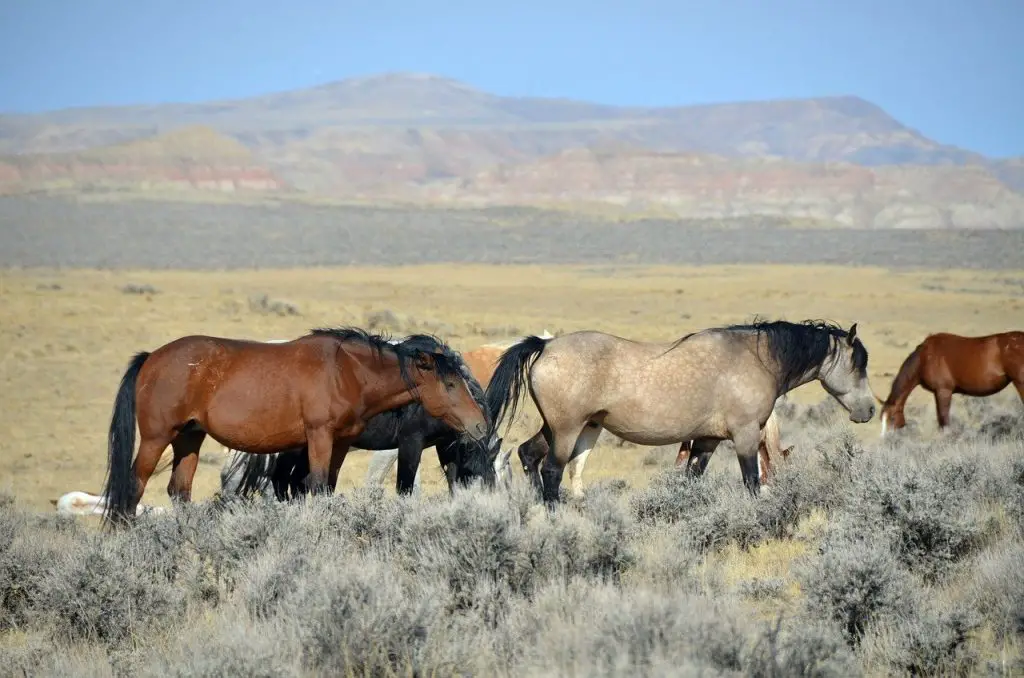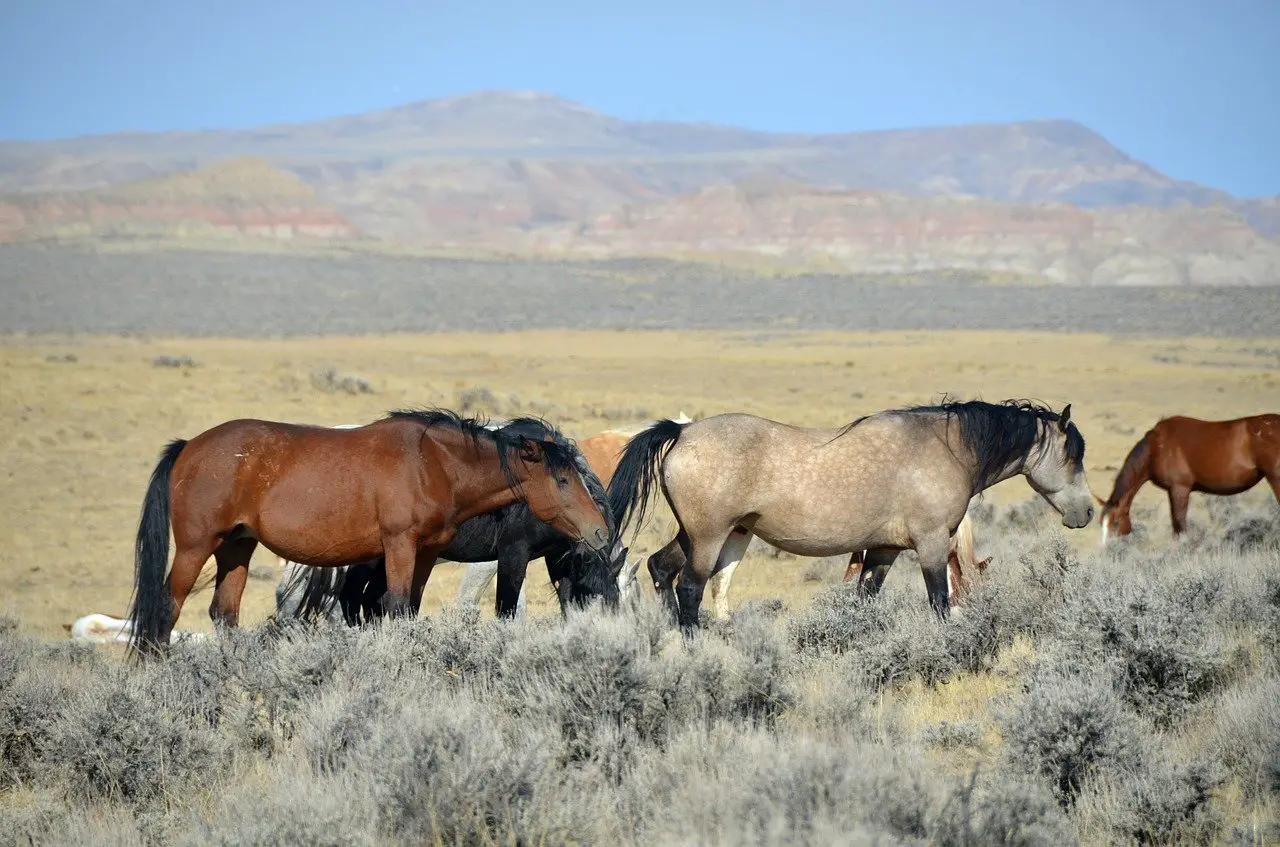Last Updated on February 23, 2022 by Allison Price
Wild horses can be dangerous prey animals, especially when they are in unfamiliar and confined environments. They perceive humans as a threat because they aren’t used to us. Horses will attack if they feel threatened and don’t have a place to retreat.
It is amazing to see wild horses on the plains. These animals should not be treated as pets.
Are wild horses capable of attacking you?
Before we arrived at the facility to view the horses, we told the children that they should not approach the mustangs. But, I was curious if they would attack unprovoked.
Although wild horses are capable of attacking humans, they do not often do so. Wild horses are prey animals and will flee from danger. Stallions and horses can become aggressive if they are separated from their herd.
People often want to touch wild horses, but it is best to keep your distance to ensure their safety and best interests. Horses can injure people seriously and are powerful, large animals.
Horses can seriously injure humans.
This video shows a mare who attacked and bit its owners multiple times. Clinton Anderson, a respected horse trainer, explains the reasons horses attack and how he helps this animal to stop its bad behavior.
Horses’ rear leg kicks can break bones and cause death in animals and humans. A horse kick has caused many people to die. Avoid standing behind horses; it is best to stay near the horse’s shoulder.
Horses are powerful and can inflict serious injury with just a single bite. Horses that aren’t afraid or able to flee from danger will bite and stomp on their opponents with their front legs.
Stallions will fight for control of a herd by grabbing their hind legs, kicking each other and trying to bite one another. horses are frightened when humans approach them .
What should you do if you spot a wild horse in the wild?
If you are lucky enough to encounter wild horses while on a hike, camping trip or other activity, allow them to move. It is forbidden to be within 50 feet of wild animals. There are separate regulations for most parks and the Bureau of Land Management.
If you expect to come into contact with wild horses, make sure you check with the BLM or park rangers about the requirements for the area you are visiting. Although the rule of thumb is to give wild horses a 50-foot buffer, some parks won’t allow you to be closer than 100 feet.

Respect their habitat and don’t walk through herds. Don’t leave any trash or feed wild horses. It is important to be as non-intrusive and as minimal as possible.
If you’re in a car, but want to see wild animals, please stay on the designated tracks and turn off your engine.
Why is wild horse riding a problem?
Wild horses are reproducing rapidly and putting stress on the natural environment. The number of wild horses is increasing at a rate 20 percent per annum. Their grazing has already decimated native plants and threatened other wildlife.
Overpopulation can lead to a loss of grasslands, which will eventually cause starvation and death in horses and other wildlife. It can also cause environmental destruction and erosion, which can lead to havoc for the environment.
The eco-system may be destroyed if wild horses continue to grow at their current rate. Here are some population estimates taken from the United States Department of Interior 2019 report wild horses and burros
- Total wild horses on public rangeland-88,000
- About 72,000 wild horses are part of this group
- Over 16,000 burros are estimated
- The BLM houses approximately 50,000 animals in government holdings, along with horses and burros.
- According to the Government, there are enough water and grazing areas for approximately 26,500 animals.
- The number of wild horses in the world is three times greater than that of available resources.
The BLM also estimated that wild horses kept in captivity would cost approximately $50,000 each over their lifetime. The cost of treating and caring for the animals in the current population was estimated at one billion dollars.https://www.youtube.com/embed/CjjRuBNiJ1k?feature=oembed
What is the BLM doing with wild horses?
The THE WILD-FREE-ROAMING HORSES and BURROS Act OF 1971
Population control
The BLM must limit the number of horses allowed to roam on public land in order to protect the land as well as the animals. They use a two-pronged approach to facilitate this. The first is to remove the animals and the second is to control their reproduction ability.
The BLM takes horses out of herds with the aim of placing them in safe and loving homes. The BLM usually removes horses from herds where they are having the greatest impact. The goal of the BLM is to remove and place 9,000 horses or burros.
The BLM is actively working with other agencies to reduce the number of wild horses being born. They do not have a long-term solution.
The anti-fertility vaccination is only effective for 12 months. It requires a booster in 15-30 days. This program has two problems. The first is that the follow-up shot can only be done if the herd has been tracked. Second, even if the booster is given, its effectiveness is limited after one year.
Because wild horses travel such a large distance, annual treatment is not practical. The BLM works with universities and private firms to create more effective drug and permanent sterilization methods.
Wild horses: Facts
These horses are thought to be the descendants of horses that were brought over by conquistadors in 16 century. Because their owners couldn’t care for them anymore, the horses fled or were left to wander free.
Native Americans captured many of these horses and used them for transport. Rest of the horses lived in the wild where the strong survived, and evolved into wild mustangs that we now know.
Wild horses physical characteristics
Although wild horses may not be the same, most have evolved to be tough, strong, and able-bodied animals. Many horses live in small groups with one dominant stallion.
Mustangs are smaller than most, at 14 to 15 hands high. They can be found in many colors but their dominant colors are bay or sorrel. Wild horses live a long time, with some reaching 40 years of age.
Wild horses are not endangered.
Wild horses are on the rise. There are currently over 88,000 mustangs roaming public land. They could easily double that number within 4 to 5 years, if they keep reproducing at the same rate.
Wild horses are protected
1971 saw Congress pass legislation to protect wild horses, burros and other animals. The act is called


